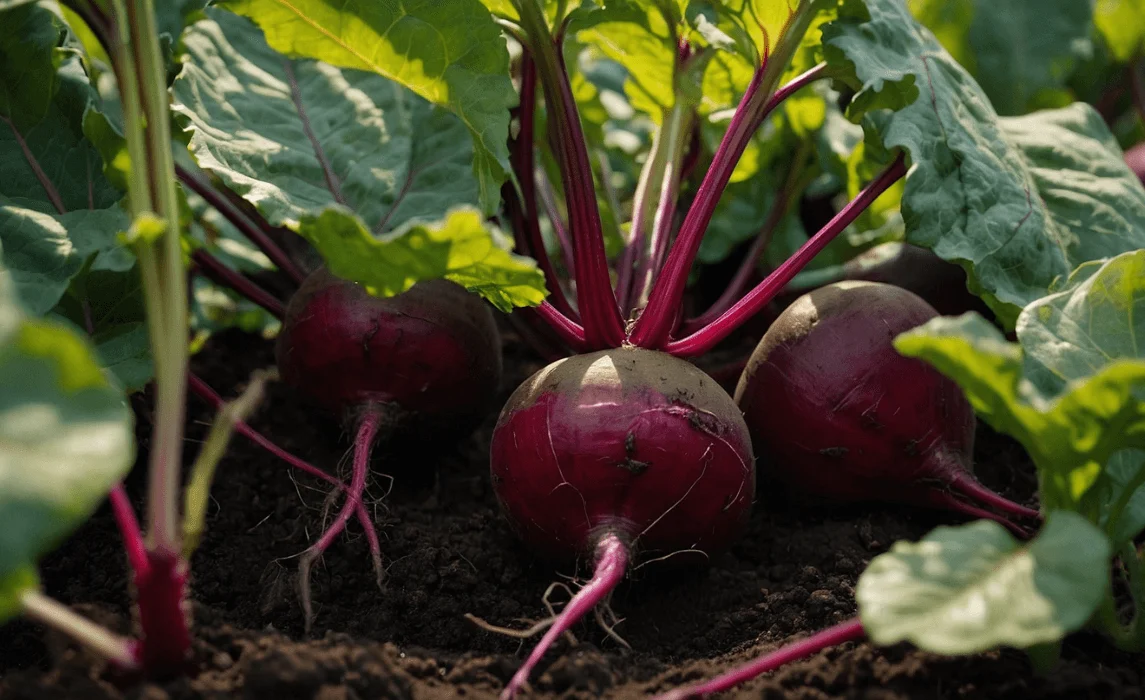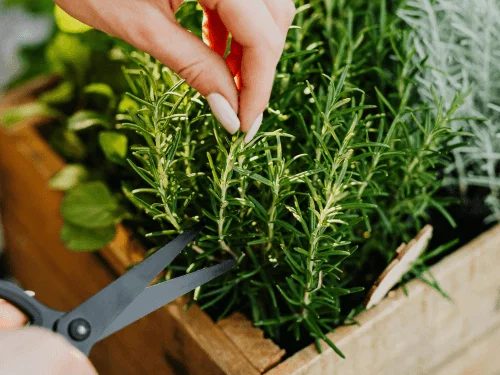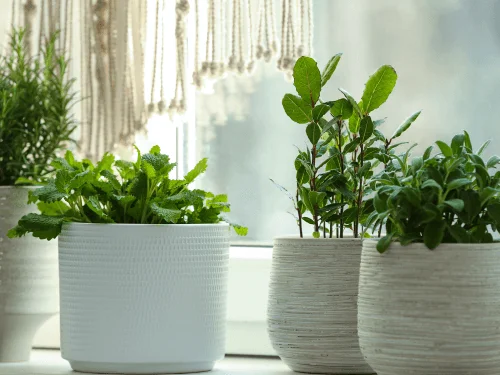Easy to Grow Vegetables: A Beginner's Guide to Simple and Productive Gardening

Q: How often should I prune my herbs?
A: Most herbs benefit from trimming every 1–2 weeks during active growth. Fast growers like basil and mint can be pruned more often, while woody herbs like rosemary need lighter, less frequent trimming.
Q: Can I prune herbs if they are flowering?
A: Yes — especially annual herbs. Remove small flower buds quickly to keep the plant producing leaves. If the herb has already fully flowered and gone to seed, harvest what you can and consider replanting new seeds.
Q: Should I prune herbs in winter?
A: Only if they are actively growing indoors. Most outdoor herbs slow down in winter, so minimal pruning reduces stress. Focus on light shaping and removing dead or brown stems.
Q: What tool should I use to trim herbs?
A: Use clean, sharp pruning shears or scissors. Keeping tools sanitized prevents disease transmission and helps make clean cuts that heal faster.
Q: Will pruning make my herbs grow back bigger?
A: Yes! Correct pruning encourages plants to produce more lateral shoots, resulting in bushier, healthier herbs with more stems and leaves.
1. Can windowsill plants improve indoor air quality?
Yes, several houseplants, including snake plants, pothos, and spider plants, are known for their air-purifying abilities, removing toxins such as formaldehyde and benzene from indoor air. While plants won’t replace proper ventilation, they do contribute to improved air quality and add natural humidity to dry indoor environments.
2. How can I keep my windowsill plants healthy in winter?
During winter, light intensity decreases, and indoor heating can dry the air. Place your plants on windowsills with maximum sunlight, avoid overwatering, and increase humidity using a tray of water or a small humidifier. Sensitive flowering plants like geraniums or African violets may benefit from supplemental grow lights to maintain bloom and foliage quality during shorter winter days.
3. Can I grow flowering and foliage plants together on the same windowsill?
Yes, but pay attention to their light and water requirements. Group plants with similar needs—sun-loving succulents together and shade-tolerant foliage like snake plants and pothos separately. This prevents overwatering or underexposure and ensures all plants thrive. Rotating flowering plants occasionally can also help blooms develop evenly.
Can mango trees be grown in pots?
A: Yes, potted mango trees require large containers with well-draining soil. Regular repotting and sunlight exposure are essential to grow a healthy mango tree in a pot.
Can mango trees grow indoors?
A: Yes, young mango trees can grow indoors in large pots with sufficient sunlight or grow lights. Indoor mango trees may take longer to flower and fruit but are manageable with proper care.
How do I grow mango trees from seed faster?
A: Using warm conditions, consistent moisture, and polyembryonic seeds can speed up germination. Grafting onto seedling rootstocks is another method to grow mango trees faster and ensure quality fruit.
When do mango trees produce fruit?
A: Grafted mango trees may bear fruit in three to five years, while seed-grown trees may take five to eight years. Flowering and fruiting are influenced by climate, sunlight, and proper mango tree care.
Gardening can be both rewarding and enjoyable, especially when you choose the right plants. For those just starting out, picking the easiest vegetables to grow can make a significant difference. Whether you’re cultivating a garden bed in your backyard or growing in pots on a windowsill, certain vegetables stand out for their simplicity and quick harvest times. From green onions to bell peppers, these crops are not only easy to care for but also versatile in various growing environments.
If you’re ready to dive into gardening but unsure where to start, this guide will help you choose the best vegetables for beginners, ideal for growing in containers or raised beds. We’ll explore how to grow plants from seeds, the best times to plant, and how to ensure a successful harvest. Learn about the vegetables that are easy to grow at home and discover the joy of harvesting fresh produce with minimal effort.
12 Easy to Grow Vegetables
Here are ten vegetables that are easy to grow. These are perfect for beginner gardeners or anyone looking for a low-maintenance garden:
1. Lettuce

Lettuce, a popular leafy green, is ideal for both beginners and seasoned gardeners due to its rapid growth and versatility in the kitchen. Lettuce plants form a rosette of leaves that vary in color from light green to deep red, and they typically reach 6-12 inches in height. They are best sown directly into well-drained, fertile soil that has been enriched with compost. Lettuce thrives in cooler temperatures and partial shade but can also adapt to full sun in cooler climates. For optimal growth, water consistently to keep the soil moist but not waterlogged, and maintain temperatures between 60-70°F (15-21°C). Regular harvesting of the outer leaves encourages continuous growth and prevents bolting. Lettuce is perfect for gardeners with limited space or those looking for a low-maintenance vegetable that provides a quick harvest.
2. Radishes

Radishes are celebrated for their fast growth and zesty flavor, making them a favorite among gardeners who appreciate quick results. These root vegetables have round, edible bulbs that come in colors such as red, white, and purple, with green, crisp leaves that sprout above the soil. Radishes are planted directly into the garden in well-drained soil that is kept consistently moist. They grow best in cooler temperatures, thriving in full sun or partial shade. Radishes mature rapidly, usually within 3-4 weeks, and should be harvested promptly to avoid becoming woody. To care for radishes, ensure the soil remains moist and use mulch to retain moisture and regulate soil temperature. Radishes are ideal for busy gardeners who want a quick-growing vegetable and can be grown in small or container gardens.
3. Carrots

Carrots are a beloved root vegetable known for their sweet flavor and nutritional benefits. They produce long, slender roots that can range from orange to purple, with green, feathery tops. Carrots require loose, sandy soil to develop properly and are typically sown directly into the garden. They prefer cooler temperatures and full sun but can tolerate partial shade. Carrots should be watered deeply but infrequently to encourage deep root growth, and the soil should be kept free of stones and debris. They thrive in temperatures between 55-75°F (13-24°C). Carrots are best suited for gardeners who have the patience to wait for a longer growing period and those who can ensure the soil conditions are right for optimal root development.
4. Zucchini

Zucchini is a prolific summer squash known for its high yield and versatility in cooking. The plants produce large, broad leaves and cylindrical fruits that come in green or yellow. Zucchini grows quickly and is typically started from seeds directly in the garden or from seedlings. It thrives in warm temperatures and requires full sun for optimal growth. Zucchini benefits from regular watering to keep the soil moist and from mulching to retain soil moisture and suppress weeds. Temperatures between 65-85°F (18-29°C) are ideal for zucchinis. Due to its sprawling nature, it’s recommended for gardeners with ample space or those who can use vertical gardening techniques. Zucchini is excellent for those who enjoy frequent harvests and can manage larger plants.
5. Tomatoes

Tomatoes are a staple in many gardens due to their versatility and rich flavor. They produce a range of fruit sizes and colors, from small cherry tomatoes to large beefsteak varieties. Tomato plants have green, compound leaves and require support such as cages or stakes due to their sprawling growth habit. They are grown from seeds or transplants and thrive in warm climates with full sun exposure. Tomatoes need well-drained soil enriched with compost and should be watered deeply and regularly. Ideal temperatures for tomato growth are between 70-85°F (21-29°C). To maintain plant health, prune lower leaves to improve air circulation and prevent diseases. Tomatoes are suited for intermediate to experienced gardeners who can provide plant support and manage larger growth.
6. Cucumbers

Cucumbers are valued for their crisp texture and refreshing taste, often used in salads and pickles. These plants have large, rough leaves and produce elongated green fruits. Cucumbers can be started from seeds or transplants and prefer warm temperatures and ample space for their vines to spread. They thrive in full sun and well-drained soil, with temperatures between 65-85°F (18-29°C). Regular watering is crucial, and using mulch can help retain soil moisture and regulate temperature. For climbing varieties, provide trellises to save space and promote healthy growth. Cucumbers are ideal for gardeners who can manage vine growth and are interested in vertical gardening techniques.
7. Beans

Beans, including both bush and pole varieties, are appreciated for their high protein content and ability to enrich soil with nitrogen. Bush beans grow compactly, while pole beans climb and need support. They produce lush green leaves and colorful pods. Beans are typically started from seeds directly in the garden and require full sun and well-drained soil. They thrive in temperatures between 60-80°F (15-27°C). Beans need consistent moisture, and it’s important to ensure good air circulation around the plants to prevent diseases. Pole beans require staking or trellising to support their climbing habit. Beans are perfect for gardeners who have space for vertical growth or those looking for plants that improve soil fertility.
8. Spinach

Spinach is a highly nutritious leafy green that is versatile in cooking and provides a continuous harvest of tender, dark green leaves. Spinach grows well in cooler weather and can be started from seeds or transplants in rich, well-drained soil. It prefers full sun or partial shade and thrives in temperatures between 50-70°F (10-21°C). Consistent moisture is essential, so keep the soil evenly moist and use compost to enrich it. Regular harvesting of outer leaves promotes new growth and prevents bolting. Spinach is well-suited for beginners and gardeners in cooler climates or those with partial shade.
9. Beets

Beets are known for their sweet flavor and vibrant color, producing round or cylindrical roots and edible green tops. They grow from seeds in well-drained, fertile soil and prefer cooler temperatures. Beets thrive in full sun or partial shade and temperatures between 60-75°F (15-24°C). Regular watering is essential to keep the soil moist, and thinning seedlings ensures adequate space for root development. Mulching can help retain soil moisture and control weeds. Beets are ideal for gardeners who enjoy growing both roots and greens and those who have cooler growing conditions.
10. Swiss Chard

Swiss chard is a colorful leafy green with vibrant stems and a range of leaf colors including green, red, and yellow. The plant produces large, glossy leaves that are versatile in cooking. Swiss chard is started from seeds or transplants in rich, well-drained soil and thrives in cooler weather. It prefers full sun or partial shade and temperatures between 60-75°F (15-24°C). Regular watering keeps the soil moist, and using compost helps maintain soil fertility. Harvesting outer leaves encourages continued growth. Swiss chard is suitable for gardeners who appreciate colorful, nutritious greens and can manage regular harvesting.
11. Peas

Peas are a cool-season crop that is easy to grow and offers both shelling and snap varieties. The plants produce climbing vines with small, delicate flowers that give way to pea pods. Peas thrive in well-drained, fertile soil and are best planted in early spring or fall when temperatures are cooler, ideally between 55-70°F (13-21°C). Peas benefit from a trellis or support structure to encourage upward growth and save space. Regular watering is important to keep the soil moist but not waterlogged. Peas are perfect for gardeners who enjoy vertical gardening and want a rewarding harvest of tender, sweet pods.
12. Kale

Kale is a hardy leafy green known for its cold tolerance and nutritional benefits. The plants produce large, crinkled leaves that come in shades of green or purple. Kale thrives in cool temperatures and well-drained, fertile soil with plenty of organic matter. It can be sown directly into the garden or started from transplants and prefers temperatures between 55-75°F (13-24°C). Regular watering and mulching help retain moisture and control weeds. Harvesting the outer leaves encourages continuous growth throughout the season. Kale is ideal for beginner gardeners who want a nutritious, low-maintenance vegetable that can withstand cooler climates.
Frequently Asked Questions and Answers:
Q: What are some of the easiest vegetables to grow?
A: Some of the easiest vegetables to grow include green onions, carrots, and bell peppers. These plants are known for their low maintenance and quick growth.
Q: How do I know when my vegetables are ready to harvest?
A: Vegetables are ready to harvest when they have reached their full size and color. For example, carrots are best harvested when they are about 1/2 inch in diameter.
Q: Can I grow vegetables in pots?
A: Yes, many vegetables grow well in pots. This includes crops like tomatoes, peppers, and green onions, which can thrive in containers with the right care.
Q: What’s the best time to start growing vegetables?
A: The best time to start growing vegetables is after the last frost date in your area. You can also start growing some vegetables indoors before the outdoor growing season begins.
Q: How often should I water my vegetable plants?
A: Vegetable plants generally need regular watering, especially in warm weather. Ensure the soil remains moist but not waterlogged.









